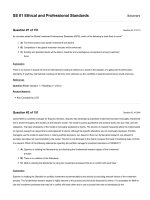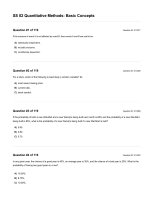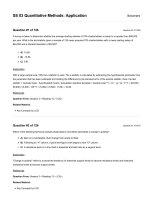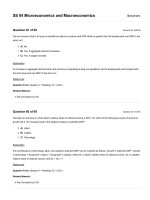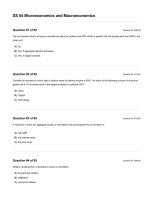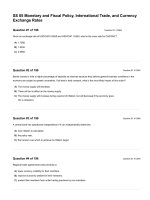CFA 2020 level i schwesernotes book 4
Bạn đang xem bản rút gọn của tài liệu. Xem và tải ngay bản đầy đủ của tài liệu tại đây (2.69 MB, 369 trang )
Contents
1. Learning Outcome Statements (LOS)
2. Reading 31: Introduction to Corporate Governance and Other ESG Considerations
1. Exam Focus
2. Module 31.1: Stakeholder Management
3. Module 31.2: Factors Affecting Corporate Governance
4. Key Concepts
5. Answer Key for Module Quizzes
3. Reading 32: Capital Budgeting
1. Exam Focus
2. Module 32.1: Capital Projects, NPV, and IRR
3. Module 32.2: Payback Period, Project Rankings
4. Key Concepts
5. Answer Key for Module Quizzes
4. Reading 33: Cost of Capital
1. Exam Focus
2. Module 33.1: Weighted Average Cost of Capital
3. Module 33.2: Project Cost of Capital
4. Key Concepts
5. Answer Key for Module Quizzes
5. Reading 34: Measures of Leverage
1. Exam Focus
2. Module 34.1: Measures of Leverage
3. Key Concepts
4. Answer Key for Module Quiz
6. Reading 35: Working Capital Management
1. Exam Focus
2. Module 35.1: Working Capital Management
3. Key Concepts
4. Answer Key for Module Quiz
7. Topic Assessment: Corporate Finance
8. Topic Assessment Answers: Corporate Finance
9. Reading 36: Market Organization and Structure
1. Exam Focus
2. Module 36.1: Markets, Assets, and Intermediaries
3. Module 36.2: Positions and Leverage
4. Module 36.3: Order Execution and Validity
5. Key Concepts
6. Answer Key for Module Quizzes
10. Reading 37: Security Market Indexes
1. Exam Focus
2. Module 37.1: Index Weighting Methods
3. Module 37.2: Uses and Types of Indexes
4. Key Concepts
5. Answer Key for Module Quizzes
11. Reading 38: Market Efficiency
1. Exam Focus
2. Module 38.1: Market Efficiency
12.
13.
14.
15.
16.
17.
18.
19.
20.
21.
3. Key Concepts
4. Answer Key for Module Quiz
Reading 39: Overview of Equity Securities
1. Exam Focus
2. Module 39.1: Types of Equity Investments
3. Module 39.2: Foreign Equities and Equity Risk
4. Key Concepts
5. Answer Key for Module Quizzes
Reading 40: Introduction to Industry and Company Analysis
1. Exam Focus
2. Module 40.1: Industry Analysis
3. Module 40.2: Pricing Power and Company Analysis
4. Key Concepts
5. Answer Key for Module Quizzes
Reading 41: Equity Valuation: Concepts and Basic Tools
1. Exam Focus
2. Module 41.1: Dividends, Splits, and Repurchases
3. Module 41.2: Dividend Discount Models
4. Module 41.3: Relative Valuation Measures
5. Key Concepts
6. Answer Key for Module Quizzes
Topic Assessment: Equity Investments
Topic Assessment Answers: Equity Investments
Reading 42: Fixed-Income Securities: Defining Elements
1. Exam Focus
2. Module 42.1: Bond Indentures, Regulation, and Taxation
3. Module 42.2: Bond Cash Flows and Contingencies
4. Key Concepts
5. Answer Key for Module Quizzes
Reading 43: Fixed-Income Markets: Issuance, Trading, and Funding
1. Exam Focus
2. Module 43.1: Types of Bonds and Issuers
3. Module 43.2: Corporate Debt and Funding Alternatives
4. Key Concepts
5. Answer Key for Module Quizzes
Reading 44: Introduction to Fixed-Income Valuation
1. Exam Focus
2. Module 44.1: Bond Valuation and Yield to Maturity
3. Module 44.2: Spot Rates and Accrued Interest
4. Module 44.3: Yield Measures
5. Module 44.4: Yield Curves
6. Module 44.5: Yield Spreads
7. Key Concepts
8. Answer Key for Module Quizzes
Reading 45: Introduction to Asset-Backed Securities
1. Exam Focus
2. Module 45.1: Structure of Mortgage-Backed Securities
3. Module 45.2: Prepayment Risk and Non-Mortgage-Backed ABS
4. Key Concepts
5. Answer Key for Module Quizzes
Reading 46: Understanding Fixed-Income Risk and Return
22.
23.
24.
25.
26.
27.
1. Exam Focus
2. Module 46.1: Sources of Returns, Duration
3. Module 46.2: Interest Rate Risk and Money Duration
4. Module 46.3: Convexity and Yield Volatility
5. Key Concepts
6. Answer Key for Module Quizzes
Reading 47: Fundamentals of Credit Analysis
1. Exam Focus
2. Module 47.1: Credit Risk and Bond Ratings
3. Module 47.2: Evaluating Credit Quality
4. Key Concepts
5. Answer Key for Module Quizzes
Topic Assessment: Fixed Income
Topic Assessment Answers: Fixed Income
Appendix
Formulas
Copyright
List of Pages
1.
2.
3.
4.
5.
6.
7.
8.
9.
10.
11.
12.
13.
14.
15.
16.
17.
18.
19.
20.
21.
22.
23.
24.
25.
26.
27.
28.
29.
30.
31.
32.
33.
34.
35.
36.
37.
38.
39.
40.
41.
42.
43.
44.
45.
46.
47.
vii
viii
ix
x
xi
xii
xiii
xiv
1
2
3
4
5
6
7
8
9
10
11
12
13
14
15
16
17
18
19
21
22
23
24
25
26
27
28
29
30
31
32
33
34
35
36
37
38
39
40
48.
49.
50.
51.
52.
53.
54.
55.
56.
57.
58.
59.
60.
61.
62.
63.
64.
65.
66.
67.
68.
69.
70.
71.
72.
73.
74.
75.
76.
77.
78.
79.
80.
81.
82.
83.
84.
85.
86.
87.
88.
89.
90.
91.
92.
93.
94.
95.
96.
97.
98.
41
42
43
44
45
46
47
48
49
50
51
52
53
54
55
56
57
58
59
60
61
62
63
64
65
66
67
68
69
70
71
72
73
74
75
77
78
79
80
81
82
83
84
85
86
87
88
89
90
91
92
99.
100.
101.
102.
103.
104.
105.
106.
107.
108.
109.
110.
111.
112.
113.
114.
115.
116.
117.
118.
119.
120.
121.
122.
123.
124.
125.
126.
127.
128.
129.
130.
131.
132.
133.
134.
135.
136.
137.
138.
139.
140.
141.
142.
143.
144.
145.
146.
147.
148.
149.
93
94
95
96
97
99
100
101
102
103
104
105
106
107
108
109
110
111
112
113
114
115
116
117
118
119
120
121
122
123
124
125
126
127
129
130
131
132
133
134
135
136
137
138
139
140
141
142
143
144
145
150.
151.
152.
153.
154.
155.
156.
157.
158.
159.
160.
161.
162.
163.
164.
165.
166.
167.
168.
169.
170.
171.
172.
173.
174.
175.
176.
177.
178.
179.
180.
181.
182.
183.
184.
185.
186.
187.
188.
189.
190.
191.
192.
193.
194.
195.
196.
197.
198.
199.
200.
146
147
149
150
151
152
153
154
155
156
157
158
159
160
161
163
164
165
166
167
168
169
170
171
172
173
174
175
177
178
179
180
181
182
183
184
185
186
187
188
189
190
191
192
193
194
195
196
197
198
199
201.
202.
203.
204.
205.
206.
207.
208.
209.
210.
211.
212.
213.
214.
215.
216.
217.
218.
219.
220.
221.
222.
223.
224.
225.
226.
227.
228.
229.
230.
231.
232.
233.
234.
235.
236.
237.
238.
239.
240.
241.
242.
243.
244.
245.
246.
247.
248.
249.
250.
251.
201
202
203
204
205
206
207
208
209
210
211
212
213
214
215
216
217
218
219
220
221
222
223
224
225
226
227
228
229
230
231
232
233
234
235
236
237
238
239
240
241
242
243
244
245
246
247
248
249
250
251
252.
253.
254.
255.
256.
257.
258.
259.
260.
261.
262.
263.
264.
265.
266.
267.
268.
269.
270.
271.
272.
273.
274.
275.
276.
277.
278.
279.
280.
281.
282.
283.
284.
285.
286.
287.
288.
289.
290.
291.
292.
293.
294.
295.
296.
297.
298.
299.
300.
301.
302.
252
253
254
255
256
257
258
259
260
261
262
263
264
265
266
267
268
269
270
271
272
273
274
275
276
277
278
279
280
281
282
283
284
285
286
287
288
289
290
291
292
293
294
295
296
297
298
299
300
301
302
303.
304.
305.
306.
307.
308.
309.
310.
311.
312.
313.
314.
315.
316.
317.
318.
319.
320.
321.
322.
323.
324.
325.
326.
327.
328.
329.
330.
331.
332.
333.
334.
335.
336.
337.
338.
339.
340.
341.
342.
343.
344.
345.
346.
347.
348.
349.
350.
351.
352.
353.
303
304
305
306
307
308
309
310
311
312
313
314
315
316
317
318
319
320
321
322
323
324
325
327
328
329
330
331
332
333
334
335
336
337
338
339
340
341
342
343
344
345
346
347
348
349
350
351
352
353
355
354.
355.
356.
357.
358.
359.
360.
361.
362.
363.
364.
365.
366.
367.
368.
369.
370.
371.
372.
373.
374.
375.
376.
377.
378.
379.
380.
381.
382.
383.
384.
385.
386.
356
357
358
359
360
361
362
363
364
365
366
367
368
369
370
371
372
373
374
375
376
377
378
379
381
382
383
384
385
386
387
388
389
LEARNING OUTCOME STATEMENTS (LOS)
STUDY SESSION 10
The topical coverage corresponds with the following CFA Institute assigned reading:
31. Introduction to Corporate Governance and Other ESG Considerations
The candidate should be able to:
a. describe corporate governance. (page 1)
b. describe a company’s stakeholder groups and compare interests of stakeholder groups.
(page 2)
c. describe principal–agent and other relationships in corporate governance and the
conflicts that may arise in these relationships. (page 3)
d. describe stakeholder management. (page 4)
e. describe mechanisms to manage stakeholder relationships and mitigate associated risks.
(page 4)
f. describe functions and responsibilities of a company’s board of directors and its
committees. (page 5)
g. describe market and non-market factors that can affect stakeholder relationships and
corporate governance. (page 8)
h. identify potential risks of poor corporate governance and stakeholder management and
identify benefits from effective corporate governance and stakeholder management.
(page 10)
i. describe factors relevant to the analysis of corporate governance and stakeholder
management. (page 11)
j. describe environmental and social considerations in investment analysis. (page 13)
k. describe how environmental, social, and governance factors may be used in investment
analysis. (page 13)
The topical coverage corresponds with the following CFA Institute assigned reading:
32. Capital Budgeting
The candidate should be able to:
a. describe the capital budgeting process and distinguish among the various categories of
capital projects. (page 21)
b. describe the basic principles of capital budgeting. (page 23)
c. explain how the evaluation and selection of capital projects is affected by mutually
exclusive projects, project sequencing, and capital rationing. (page 24)
d. calculate and interpret net present value (NPV), internal rate of return (IRR), payback
period, discounted payback period, and profitability index (PI) of a single capital
project. (page 25)
e. explain the NPV profile, compare the NPV and IRR methods when evaluating
independent and mutually exclusive projects, and describe the problems associated with
each of the evaluation methods. (page 31)
f. contrast the NPV decision rule to the IRR decision rule and identify problems associated
with the IRR rule. (page 33)
g. describe expected relations among an investment’s NPV, company value, and share
price. (page 35)
The topical coverage corresponds with the following CFA Institute assigned reading:
33. Cost of Capital
The candidate should be able to:
a. calculate and interpret the weighted average cost of capital (WACC) of a company.
(page 41)
b. describe how taxes affect the cost of capital from different capital sources. (page 41)
c. describe the use of target capital structure in estimating WACC and how target capital
structure weights may be determined. (page 43)
d. explain how the marginal cost of capital and the investment opportunity schedule are
used to determine the optimal capital budget. (page 44)
e. explain the marginal cost of capital’s role in determining the net present value of a
project. (page 45)
f. calculate and interpret the cost of debt capital using the yield-to-maturity approach and
the debt-rating approach. (page 45)
g. calculate and interpret the cost of noncallable, nonconvertible preferred stock. (page 46)
h. calculate and interpret the cost of equity capital using the capital asset pricing model
approach, the dividend discount model approach, and the bond-yield-plus risk-premium
approach. (page 47)
i. calculate and interpret the beta and cost of capital for a project. (page 50)
j. describe uses of country risk premiums in estimating the cost of equity. (page 52)
k. describe the marginal cost of capital schedule, explain why it may be upward-sloping
with respect to additional capital, and calculate and interpret its break-points. (page 53)
l. explain and demonstrate the correct treatment of flotation costs. (page 55)
STUDY SESSION 11
The topical coverage corresponds with the following CFA Institute assigned reading:
34. Measures of Leverage
The candidate should be able to:
a. define and explain leverage, business risk, sales risk, operating risk, and financial risk
and classify a risk. (page 63)
b. calculate and interpret the degree of operating leverage, the degree of financial
leverage, and the degree of total leverage. (page 64)
c. analyze the effect of financial leverage on a company’s net income and return on equity.
(page 67)
d. calculate the breakeven quantity of sales and determine the company’s net income at
various sales levels. (page 68)
e. calculate and interpret the operating breakeven quantity of sales. (page 68)
The topical coverage corresponds with the following CFA Institute assigned reading:
35. Working Capital Management
The candidate should be able to:
a. describe primary and secondary sources of liquidity and factors that influence a
company’s liquidity position. (page 77)
b. compare a company’s liquidity measures with those of peer companies. (page 78)
c. evaluate working capital effectiveness of a company based on its operating and cash
conversion cycles and compare the company’s effectiveness with that of peer
companies. (page 80)
d. describe how different types of cash flows affect a company’s net daily cash position.
(page 81)
e. calculate and interpret comparable yields on various securities, compare portfolio
returns against a standard benchmark, and evaluate a company’s short-term investment
policy guidelines. (page 81)
f. evaluate a company’s management of accounts receivable, inventory, and accounts
payable over time and compared to peer companies. (page 83)
g. evaluate the choices of short-term funding available to a company and recommend a
financing method. (page 86)
STUDY SESSION 12
The topical coverage corresponds with the following CFA Institute assigned reading:
36. Market Organization and Structure
The candidate should be able to:
a. explain the main functions of the financial system. (page 99)
b. describe classifications of assets and markets. (page 101)
c. describe the major types of securities, currencies, contracts, commodities, and real
assets that trade in organized markets, including their distinguishing characteristics and
major subtypes. (page 102)
d. describe types of financial intermediaries and services that they provide. (page 105)
e. compare positions an investor can take in an asset. (page 108)
f. calculate and interpret the leverage ratio, the rate of return on a margin transaction, and
the security price at which the investor would receive a margin call. (page 110)
g. compare execution, validity, and clearing instructions. (page 112)
h. compare market orders with limit orders. (page 112)
i. define primary and secondary markets and explain how secondary markets support
primary markets. (page 115)
j. describe how securities, contracts, and currencies are traded in quote-driven, orderdriven, and brokered markets. (page 117)
k. describe characteristics of a well-functioning financial system. (page 119)
l. describe objectives of market regulation. (page 120)
The topical coverage corresponds with the following CFA Institute assigned reading:
37. Security Market Indexes
The candidate should be able to:
a. describe a security market index. (page 129)
b. calculate and interpret the value, price return, and total return of an index. (page 129)
c. describe the choices and issues in index construction and management. (page 130)
d. compare the different weighting methods used in index construction. (page 130)
e. calculate and analyze the value and return of an index given its weighting method.
(page 133)
f. describe rebalancing and reconstitution of an index. (page 137)
g. describe uses of security market indexes. (page 137)
h. describe types of equity indexes. (page 138)
i. describe types of fixed-income indexes. (page 139)
j. describe indexes representing alternative investments. (page 139)
k. compare types of security market indexes. (page 141)
The topical coverage corresponds with the following CFA Institute assigned reading:
38. Market Efficiency
The candidate should be able to:
a. describe market efficiency and related concepts, including their importance to
investment practitioners. (page 149)
b. distinguish between market value and intrinsic value. (page 150)
c. explain factors that affect a market’s efficiency. (page 150)
d. contrast weak-form, semi-strong-form, and strong-form market efficiency. (page 151)
e. explain the implications of each form of market efficiency for fundamental analysis,
technical analysis, and the choice between active and passive portfolio management.
(page 152)
f. describe market anomalies. (page 153)
g. describe behavioral finance and its potential relevance to understanding market
anomalies. (page 156)
STUDY SESSION 13
The topical coverage corresponds with the following CFA Institute assigned reading:
39. Overview of Equity Securities
The candidate should be able to:
a. describe characteristics of types of equity securities. (page 163)
b. describe differences in voting rights and other ownership characteristics among
different equity classes. (page 165)
c. distinguish between public and private equity securities. (page 165)
d. describe methods for investing in non-domestic equity securities. (page 166)
e. compare the risk and return characteristics of different types of equity securities.
(page 168)
f. explain the role of equity securities in the financing of a company’s assets. (page 169)
g. distinguish between the market value and book value of equity securities. (page 169)
h. compare a company’s cost of equity, its (accounting) return on equity, and investors’
required rates of return. (page 170)
The topical coverage corresponds with the following CFA Institute assigned reading:
40. Introduction to Industry and Company Analysis
The candidate should be able to:
a. explain uses of industry analysis and the relation of industry analysis to company
analysis. (page 177)
b. compare methods by which companies can be grouped, current industry classification
systems, and classify a company, given a description of its activities and the
classification system. (page 178)
c. explain the factors that affect the sensitivity of a company to the business cycle and the
uses and limitations of industry and company descriptors such as “growth,”
“defensive,” and “cyclical.” (page 181)
d. explain how a company’s industry classification can be used to identify a potential
“peer group” for equity valuation. (page 182)
e. describe the elements that need to be covered in a thorough industry analysis.
(page 182)
f. describe the principles of strategic analysis of an industry. (page 183)
g. explain the effects of barriers to entry, industry concentration, industry capacity, and
market share stability on pricing power and price competition. (page 185)
h. describe industry life cycle models, classify an industry as to life cycle stage, and
describe limitations of the life-cycle concept in forecasting industry performance.
(page 187)
i. compare characteristics of representative industries from the various economic sectors.
(page 189)
j. describe macroeconomic, technological, demographic, governmental, and social
influences on industry growth, profitability, and risk. (page 190)
k. describe the elements that should be covered in a thorough company analysis.
(page 191)
The topical coverage corresponds with the following CFA Institute assigned reading:
41. Equity Valuation: Concepts and Basic Tools
The candidate should be able to:
a. evaluate whether a security, given its current market price and a value estimate, is
overvalued, fairly valued, or undervalued by the market. (page 201)
b. describe major categories of equity valuation models. (page 202)
c. describe regular cash dividends, extra dividends, stock dividends, stock splits, reverse
stock splits, and share repurchases. (page 203)
d. describe dividend payment chronology. (page 204)
e. explain the rationale for using present value models to value equity and describe the
dividend discount and free-cash-flow-to-equity models. (page 205)
f. calculate the intrinsic value of a non-callable, non-convertible preferred stock.
(page 208)
g. calculate and interpret the intrinsic value of an equity security based on the Gordon
(constant) growth dividend discount model or a two-stage dividend discount model, as
appropriate. (page 208)
h. identify characteristics of companies for which the constant growth or a multistage
dividend discount model is appropriate. (page 213)
i. explain the rationale for using price multiples to value equity, how the price to earnings
multiple relates to fundamentals, and the use of multiples based on comparables.
(page 214)
j. calculate and interpret the following multiples: price to earnings, price to an estimate of
operating cash flow, price to sales, and price to book value. (page 215)
k. describe enterprise value multiples and their use in estimating equity value. (page 219)
l. describe asset-based valuation models and their use in estimating equity value.
(page 220)
m. explain advantages and disadvantages of each category of valuation model. (page 222)
STUDY SESSION 14
The topical coverage corresponds with the following CFA Institute assigned reading:
42. Fixed-Income Securities: Defining Elements
The candidate should be able to:
a. describe basic features of a fixed-income security. (page 238)
b. describe content of a bond indenture. (page 239)
c. compare affirmative and negative covenants and identify examples of each. (page 239)
d. describe how legal, regulatory, and tax considerations affect the issuance and trading of
fixed-income securities. (page 240)
e. describe how cash flows of fixed-income securities are structured. (page 244)
f. describe contingency provisions affecting the timing and/or nature of cash flows of
fixed-income securities and identify whether such provisions benefit the borrower or the
lender. (page 248)
The topical coverage corresponds with the following CFA Institute assigned reading:
43. Fixed-Income Markets: Issuance, Trading, and Funding
The candidate should be able to:
a. describe classifications of global fixed-income markets. (page 255)
b. describe the use of interbank offered rates as reference rates in floating-rate debt.
(page 256)
c. describe mechanisms available for issuing bonds in primary markets. (page 257)
d. describe secondary markets for bonds. (page 258)
e. describe securities issued by sovereign governments. (page 258)
f. describe securities issued by non-sovereign governments, quasi-government entities,
and supranational agencies. (page 259)
g. describe types of debt issued by corporations. (page 260)
h. describe structured financial instruments. (page 262)
i. describe short-term funding alternatives available to banks. (page 264)
j. describe repurchase agreements (repos) and the risks associated with them. (page 265)
The topical coverage corresponds with the following CFA Institute assigned reading:
44. Introduction to Fixed-Income Valuation
The candidate should be able to:
a. calculate a bond’s price given a market discount rate. (page 271)
b. identify the relationships among a bond’s price, coupon rate, maturity, and market
discount rate (yield-to-maturity). (page 273)
c. define spot rates and calculate the price of a bond using spot rates. (page 276)
d. describe and calculate the flat price, accrued interest, and the full price of a bond.
(page 277)
e. describe matrix pricing. (page 278)
f. calculate annual yield on a bond for varying compounding periods in a year. (page 280)
g. calculate and interpret yield measures for fixed-rate bonds and floating-rate notes.
(page 280)
h. calculate and interpret yield measures for money market instruments. (page 286)
i. define and compare the spot curve, yield curve on coupon bonds, par curve, and forward
curve. (page 288)
j. define forward rates and calculate spot rates from forward rates, forward rates from spot
rates, and the price of a bond using forward rates. (page 290)
k. compare, calculate, and interpret yield spread measures. (page 294)
The topical coverage corresponds with the following CFA Institute assigned reading:
45. Introduction to Asset-Backed Securities
The candidate should be able to:
a. explain benefits of securitization for economies and financial markets. (page 303)
b. describe securitization, including the parties involved in the process and the roles they
play. (page 304)
c. describe typical structures of securitizations, including credit tranching and time
tranching. (page 306)
d. describe types and characteristics of residential mortgage loans that are typically
securitized. (page 307)
e. describe types and characteristics of residential mortgage-backed securities, including
mortgage pass-through securities and collateralized mortgage obligations, and explain
the cash flows and risks for each type. (page 309)
f. define prepayment risk and describe the prepayment risk of mortgage-backed securities.
(page 309)
g. describe characteristics and risks of commercial mortgage-backed securities. (page 315)
h. describe types and characteristics of non-mortgage asset-backed securities, including
the cash flows and risks of each type. (page 317)
i. describe collateralized debt obligations, including their cash flows and risks. (page 319)
STUDY SESSION 15
The topical coverage corresponds with the following CFA Institute assigned reading:
46. Understanding Fixed-Income Risk and Return
The candidate should be able to:
a. calculate and interpret the sources of return from investing in a fixed-rate bond.
(page 327)
b. define, calculate, and interpret Macaulay, modified, and effective durations. (page 333)
c. explain why effective duration is the most appropriate measure of interest rate risk for
bonds with embedded options. (page 336)
d. define key rate duration and describe the use of key rate durations in measuring the
sensitivity of bonds to changes in the shape of the benchmark yield curve. (page 338)
e. explain how a bond’s maturity, coupon, and yield level affect its interest rate risk.
(page 338)
f. calculate the duration of a portfolio and explain the limitations of portfolio duration.
(page 339)
g. calculate and interpret the money duration of a bond and price value of a basis point
(PVBP). (page 340)
h. calculate and interpret approximate convexity and distinguish between approximate and
effective convexity. (page 342)
i. Estimate the percentage price change of a bond for a specified change in yield, given the
bond’s approximate duration and convexity. (page 344)
j. describe how the term structure of yield volatility affects the interest rate risk of a bond.
(page 345)
k. describe the relationships among a bond’s holding period return, its duration, and the
investment horizon. (page 345)
l. explain how changes in credit spread and liquidity affect yield-to-maturity of a bond and
how duration and convexity can be used to estimate the price effect of the changes.
(page 347)
The topical coverage corresponds with the following CFA Institute assigned reading:
47. Fundamentals of Credit Analysis
The candidate should be able to:
a. describe credit risk and credit-related risks affecting corporate bonds. (page 355)
b. describe default probability and loss severity as components of credit risk. (page 355)
c. describe seniority rankings of corporate debt and explain the potential violation of the
priority of claims in a bankruptcy proceeding. (page 356)
d. distinguish between corporate issuer credit ratings and issue credit ratings and describe
the rating agency practice of “notching.” (page 357)
e. explain risks in relying on ratings from credit rating agencies. (page 359)
f. explain the four Cs (Capacity, Collateral, Covenants, and Character) of traditional credit
analysis. (page 359)
g. calculate and interpret financial ratios used in credit analysis. (page 363)
h. evaluate the credit quality of a corporate bond issuer and a bond of that issuer, given
key financial ratios of the issuer and the industry. (page 363)
i. describe factors that influence the level and volatility of yield spreads. (page 365)
j. explain special considerations when evaluating the credit of high yield, sovereign, and
non-sovereign government debt issuers and issues. (page 366)
The following is a review of the Corporate Finance (1) principles designed to address the learning outcome
statements set forth by CFA Institute. Cross-Reference to CFA Institute Assigned Reading #31.
READING 31: INTRODUCTION TO
CORPORATE GOVERNANCE AND OTHER
ESG CONSIDERATIONS
Study Session 10
EXAM FOCUS
Candidates should understand the idea of a firm’s stakeholders, how conflicts can arise
between stakeholders, and how effective corporate governance can mitigate problems arising
from these conflicts. Other important points are the election of the board of directors, the
board’s duties, and important factors in board composition. Finally, the rationale for
incorporating environmental, social, and governance factors into the portfolio selection
process is presented.
MODULE 31.1: STAKEHOLDER MANAGEMENT
LOS 31.a: Describe corporate governance.
CFA® Program Curriculum, Volume 4, page 6
Video covering
this content is
available online.
In the CFA Institute publication, The Corporate Governance of Listed Companies: A Manual
for Investors1, corporate governance is described as “the system of internal controls and
procedures by which individual companies are managed. It provides a framework that defines
the rights, roles and responsibilities of various groups . . . within an organization. At its core,
corporate governance is the arrangement of checks, balances, and incentives a company
needs in order to minimize and manage the conflicting interests between insiders and external
shareowners.”
Under shareholder theory, the primary focus of a system of corporate governance is the
interests of the firm’s shareholders, which are taken to be the maximization of the market
value of the firm’s common equity. Under this theory, corporate governance is primarily
concerned with the conflict of interest between the firm’s managers and its owners
(shareholders).
The focus of corporate governance under stakeholder theory is broader; it considers
conflicts among the several groups that have an interest in the activities and performance of
the firm. These groups include shareholders, employees, suppliers, and customers, among
others.
LOS 31.b: Describe a company’s stakeholder groups and compare interests of
stakeholder groups.
CFA® Program Curriculum, Volume 4, page 8
The following have been identified as the primary stakeholders of a corporation.
Shareholders have a residual interest in the corporation in that they have claim to the net
assets of the corporation after all liabilities have been settled. Shareholders have voting rights
for the election of the board of directors and for other important corporate matters, which
gives them effective control of the firm and its management. They have an interest in the
ongoing profitability and growth of the firm, both of which can increase the value of their
ownership shares.
The board of directors has a responsibility to protect the interests of shareholders; to hire,
fire, and set the compensation of the firm’s senior managers; to set the strategic direction of
the firm; and to monitor financial performance and other aspects of the firm’s ongoing
activities.
Typically, the firm’s executives (most-senior managers) serve on the board of directors, along
with directors who are not otherwise employed by the firm. In a one-tier board structure, both
company executives and non-executive board members serve on a single board of directors.
In some countries, boards have a two-tier structure in which the non-executive board
members serve on a supervisory board that oversees a management board, made up of
company executives.
Senior managers typically receive compensation (remuneration) that is made up of a salary,
a bonus based on some measure of company performance, and perquisites (e.g., expense
accounts, use of company planes, special retirement benefits, vacation time off). Their
interests can be expected to include continued employment and maximizing the total value of
their compensation. Executive bonuses are typically tied to some measure of firm
performance, giving senior managers a strong interest in the financial success of the firm.
Employees also have an interest in the sustainability and success of the firm. They have an
interest in their rate of pay, opportunities for career advancement, training, and working
conditions.
Creditors supply debt capital to the firm and are primarily owners of the firm’s outstanding
bonds and banks that have made loans to the firm. Providers of debt capital to the firm do not
typically have a vote in firm management and do not participate in firm growth beyond
receiving their promised interest and principal payments. The interests of creditors are
protected to varying degrees by covenants in their debt agreements with the firm.
Suppliers of resources to the firm have an interest preserving an ongoing relationship with
the firm, in the profitability of their trade with the firm, and in the growth and ongoing
stability of the firm. As they are typically short-term creditors of the firm, they also have an
interest in the firm’s solvency and ongoing financial strength.
LOS 31.c: Describe principal–agent and other relationships in corporate governance
and the conflicts that may arise in these relationships.
CFA® Program Curriculum, Volume 4, page 11
The principal-agent conflict arises because an agent is hired to act in the interest of the
principal, but an agent’s interests may not coincide exactly with those of the principal.
Consider an insurance agent who is paid a commission on policies written. It would be in the
agent’s interest to write insurance policies on people or property that are not good risks, in
order to maximize commission income. The principal (the owners of the insurance company)
